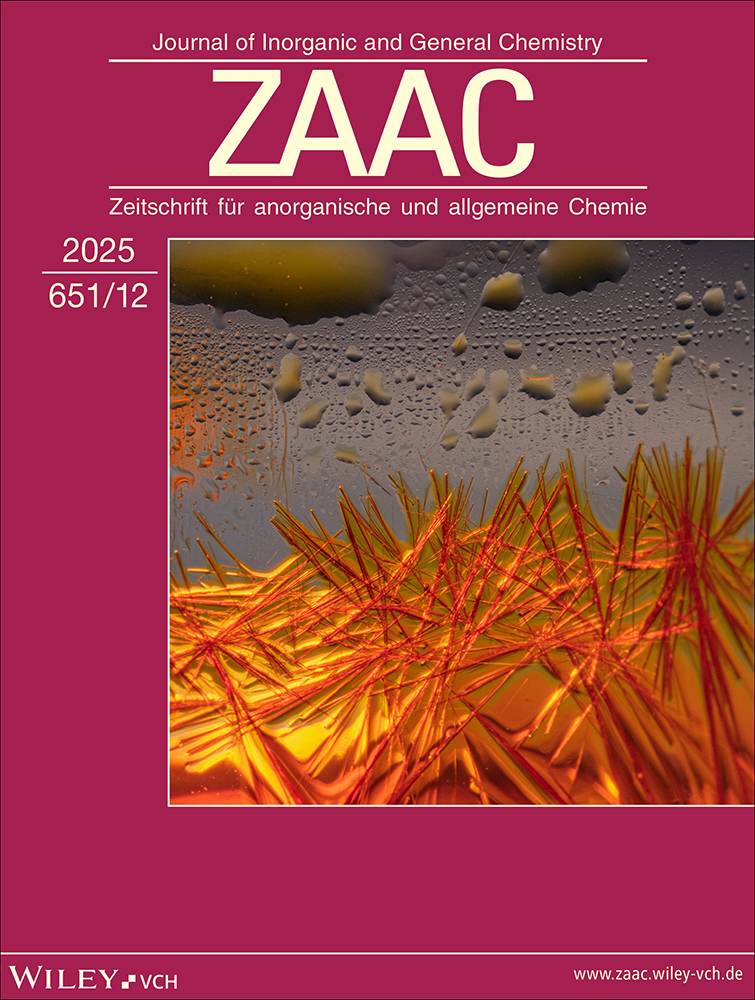Phosphaniminato-Komplexe des Hafniums. Die Kristallstrukturen von [Hf(NPPh3)4] · 3 THF und [Hf(NPPh3)2Cl2(HNPPh3)2]
Abstract
deDie Phosphaniminato-Komplexe [Hf(NPPh3)4] · 3 THF (1 · 3 THF) und [Hf(NPPh3)2Cl2(HNPPh3)2] (2) entstehen als farblose, feuchtigkeitsempfindliche Einkristalle durch Reaktion von Hafniumtetrachlorid mit [CsNPPh3]4 · 2 Toluol in Tetrahydrofuran-Lösung bei Anwendung verschiedener Mengenverhältnisse der Reaktanden. Beide Komplexe werden IR-spektroskopisch und durch Kristallstrukturanalysen charakterisiert.
1 · 3 THF: Raumgruppe P 1, Z = 4, Gitterkonstanten bei 193 K: a = 2007,6(1); b = 2064,2(1); c = 2115,9(1) pm; α = 109,193(4)°; β = 111,285(4)°; γ = 96,879(4)°; R1 = 0,0506. 1 bildet monomere Moleküle, in denen die N-Atome der (NPPh3–)-Gruppen das Hafnium-Atom tetraedrisch umgeben. Die HfN-Abstände entsprechen mit einem Mittelwert von 200,9 pm etwa Doppelbindungen.
2: Raumgruppe P 1, Z = 4, Gitterkonstanten bei 193 K: a = 1444,0(1); b = 1928,1(1); c = 2455,8(2) pm; α = 67,273(8)°; β = 87,445(8)°; γ = 87,082(8)°; R1 = 0,0312. 2 hat eine monomere Molekülstruktur mit oktaedrisch koordiniertem Hafnium-Atom. Die Chloratome befinden sich in trans-Position, während den N-Atomen der Phosphaniminato-Gruppen (NPPh3–) die N-Atome der Phosphanimin-Moleküle (HNPPh3) gegenüberstehen. Während die HfN-Abstände der (NPPh3–)-Gruppen im Mittel mit 199,7 pm Doppelbindungen entsprechen, sind die HfN-Abstände der Phosphanimin-Moleküle mit einem Mittelwert von 230,2 pm vom Donor-Akzeptor-Typ.
Abstract
enPhosphoraneiminato Complexes of Hafnium. Crystal Structures of [Hf(NPPh3)4] · 3 THF and [Hf(NPPh3)2Cl2(HNPPh3)2]
The phosphoraneiminato complexes [Hf(NPPh3)4] · 3 THF (1 · 3 THF) and [Hf(NPPh3)2Cl2(HNPPh3)2] (2) have been prepared as colourless, moisture sensitive single crystals by reactions of hafnium tetrachloride with [CsNPPh3]4 · 2 toluene in tetrahydrofurane solutions by application of different ratios of the educts. Both complexes are characterized by IR spectroscopy and X-ray crystal structure determinations.
1 · 3 THF: space group P 1, Z = 4, lattice dimensions at 193 K: a = 2007.6(1); b = 2064.2(1); c = 2115.9(1) pm; α = 109.193(4)°; β = 111.285(4)°; γ = 96.879(4)°; R1 = 0.0506. 1 forms monomeric molecules with tetrahedral coordination of the nitrogen-atoms of the (NPPh3–)-groups towards the Hafnium atom. The HfN distances of 200.9 pm in average correspond with double bonds.
2: space group P 1, Z = 4, lattice dimensions at 193 K: a = 1444.0(1); b = 1928.1(1); c = 2455.8(2) pm; α = 67.273(8)°; β = 87.445(8)°; γ = 87.082(8)°; R1 = 0.0312. 2 has a monomeric molecular structure with octahedral coordination of the hafnium atom. The chlorine atoms are in trans position to one another, whereas the nitrogen atoms of the phosphoraneiminato groups (NPPh3–) are in trans position towards the nitrogen atoms ot the phosphorane imine molecules (HNPPh3). The HfN bond lengths of the (NPPh3–) groups of 199.7 pm in average correspond with double bonds, whereas the HfN distances of the HNPPh3 molecules with bond lengths of 230.2 pm in average are of donor-acceptor type.




